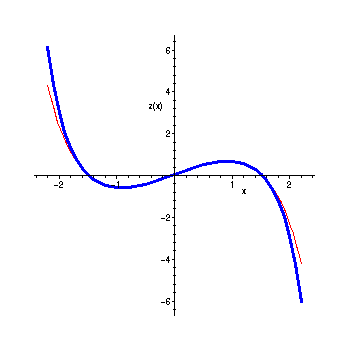![[Maple Math]](images/RedOrd1.gif) = 0 (a special case of
Hermite's equation
)
= 0 (a special case of
Hermite's equation
)
MATH 304 -- Ordinary Differential Equations
A Reduction of Order example.
October 19, 2000
For the linear second order ODE
![[Maple Math]](images/RedOrd1.gif) = 0 (a special case of
Hermite's equation
)
= 0 (a special case of
Hermite's equation
)
we derived a polynomial solution
![]() . Then the Reduction
. Then the Reduction
of Order formula gives a second solution in the form:
![[Maple Math]](images/RedOrd3.gif) =
=
![[Maple Math]](images/RedOrd4.gif)
This function cannot be expressed in terms of elementary functions, but
we can look at a Taylor series, for instance. To get the terms out to degree
d for instance, we would want to take the Taylor polynomial of degree
d -
1 for
![[Maple Math]](images/RedOrd5.gif) , integrate it, and multiply by 1 - 2
, integrate it, and multiply by 1 - 2
![]() , keeping
, keeping
only terms of degree d or less:
For instance the Taylor polynomial of degree 6 for the second solution is:
> TP6:=convert(taylor(exp(x^2)/(1-2*x^2)^2,x=0,7),polynom);
![]()
> expand((1-2*x^2)*int(TP6,x));
![]()
> y := expand((1-2*x^2)*int(TP6,x))+277*x^9/21;
![]()
(and ignore the term of degree 9). This is only an approximation to the actual solution, but
note:
> expand(diff(y,x$2) - 2*x*diff(y,x) + 4*y);
![]()
So the Taylor polynomial solves the ODE "
modulo
![]() " and should agree closely with
" and should agree closely with
the actual solution for x near 0.
> TPlot:=plot(y,x=-2.2..2.2):
> with(DEtools): with(plots):
> SolPlot:=DEplot(diff(z(x),x$2) - 2*x*diff(z(x),x) + 4*z(x),z(x),x=-2.2..2.2,[[z(0)=0,D(z)(0)=1]],linecolor=blue,stepsize=.1):
> display({TPlot,SolPlot});

>